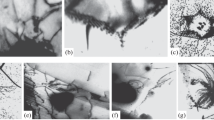Transformations of structure associated with relaxation processes in the inclusion-matrix interphase boundaries of 08Yu, 08Kh18N10T, É3 steels and armco-iron under various external impacts are studied. The possibilities of stress relaxation within the inclusion – matrix boundaries as a result of the emission of dislocations or the splitting of these boundaries are shown. The mechanisms of static, dynamic, and electrostimulated splitting, which plays an important role in structural transformations during various steel treatments, are proposed.



Similar content being viewed by others
References
S. I. Gubenko and S. P. Oshkaderov, Non-metallic Inclusions in Steel [in Russian], Naukova Dumka, Kiev (2016).
S. I. Gubenko, “Possibilities of transformation of non-metallic inclusions and inclusion – matrix interphace boundaries at high-energy treatments of steels,” Metallofiz. Noveish. Tekhnol., 36(3), 287 – 315 (2014).
S. Gubenko, Y. Proidak, A. Kozlovsky, et al., “Influence of non-metallic inclusions on microbreaks formation in wheel steel and railway wheels,” in: Materials of VIII Scientific Conference “Telematics, Logistics and Transport Safety” TLTS’08, Katowice-Cieszyn, Poland (2008), pp. 16 – 18.
S. M. Usherenko, S. I. Gubenko, and V. F. Nozdrin, “Change in the structure of iron and steel during superdeep incorporation of high-speed particles,” Izv. Akad. Nauk SSSR, Metally, No. 1, 124 – 125 (1991).
G. I. Bel’chenko and S. I. Gubenko, “Microinhomogeneous deformation of steel containing non-metallic inclusions,” Izv. Akad. Nauk SSSR, Metally, No. 4, 94 – 97 (1981).
S. I. Gubenko, Inclusion-Matrix Interphase Boundaries in Steels. Non-metallic Inclusion-Matrix Interphase Boundaries and Properties of Steels [in Russian], Palmarium Academician Publishing, Beau Bassin (2017).
V. N. Perevezentsev and V. N. Chuvil’deev, “Deformation-induced slippage along grain boundaries,” in: Physics of Defects in Materials Surface Layers [in Russian], Izd-vo LFTI, 175 – 184 (1989).
B. S. Bokshtein, I. V. Kopetsky, and L. S. Shvindlerman, Thermodynamics and Kinetics of Grain Boundaries in Metals [in Russian], Metallurgiya, Moscow (1986).
V. I. Tsotsko and A. I. Denisenko, “Temperature characteristics of the surface layer of low-carbon steels under conditions of linear surface heating,” Vestn. Dnepropetr. Nats. Univ., No. 2, 72 – 77 (2004).
V. E. Panin, V. A. Likhachev, and Yu. V. Grinyaev, Structural Levels of Solids Deformation [in Russian], Nauka, Novosibirsk (1985).
Yu. V. Grinyaev and N. V. Chertkova, “Gauge theories of plastic deformation in continuum mechanics,” Izv. Vysh. Uchebn. Zaved., Fizika, No. 2, 26 – 50 (1990).
Author information
Authors and Affiliations
Corresponding author
Additional information
Translated from Metallovedenie i Termicheskaya Obrabotka Metallov, No. 5, pp. 3 – 10, May, 2020.
Rights and permissions
About this article
Cite this article
Gubenko, S.I. Role of Inclusion – Matrix Steel Interphase Boundaries in the Development of Relaxation Processes near Nonmetallic Inclusions. Met Sci Heat Treat 62, 299–305 (2020). https://doi.org/10.1007/s11041-020-00558-5
Published:
Issue Date:
DOI: https://doi.org/10.1007/s11041-020-00558-5




